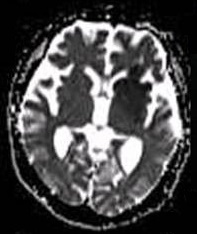|
Microinfarct
A microinfarct is a microscopic stroke generally ranging between 0.1 millimeter and 1 millimeter in size. Microinfarcts can be found in 25-50% of all elderly deceased persons. Microinfarcts may be the second most important cause of dementia, after Alzheimer's disease Alzheimer's disease (AD) is a neurodegenerative disease and the cause of 60–70% of cases of dementia. The most common early symptom is difficulty in remembering recent events. As the disease advances, symptoms can include problems wit .... Microinfarcts are microscopic lesions, of cellular death or tissue necrosis, which are a result of pathologies involving small vessels. Such pathologies are arteriosclerosis or cerebral amyloid angiopathy.Smith, Eric E. MD, Julie A. Schneider, MD, Joanna M. Wardlaw, MD, and Steven M. Greenberg, MD. “Cerebral Microinfarcts: The Invisible Lesions.” ''Lancet Neurology'' 11.3 (2012): 272–282. ''PMC''. Web. 20 Mar. 2016. Microinfarcts take longer to affect neuronal dea ... [...More Info...] [...Related Items...] OR: [Wikipedia] [Google] [Baidu] |
Stroke
Stroke is a medical condition in which poor cerebral circulation, blood flow to a part of the brain causes cell death. There are two main types of stroke: brain ischemia, ischemic, due to lack of blood flow, and intracranial hemorrhage, hemorrhagic, due to bleeding. Both cause parts of the brain to stop functioning properly. Signs and symptoms of stroke may include an hemiplegia, inability to move or feel on one side of the body, receptive aphasia, problems understanding or expressive aphasia, speaking, dizziness, or homonymous hemianopsia, loss of vision to one side. Signs and symptoms often appear soon after the stroke has occurred. If symptoms last less than 24 hours, the stroke is a transient ischemic attack (TIA), also called a mini-stroke. subarachnoid hemorrhage, Hemorrhagic stroke may also be associated with a thunderclap headache, severe headache. The symptoms of stroke can be permanent. Long-term complications may include pneumonia and Urinary incontinence, loss of b ... [...More Info...] [...Related Items...] OR: [Wikipedia] [Google] [Baidu] |
Dementia
Dementia is a syndrome associated with many neurodegenerative diseases, characterized by a general decline in cognitive abilities that affects a person's ability to perform activities of daily living, everyday activities. This typically involves problems with memory, thinking, behavior, and motor control. Aside from memory impairment and a thought disorder, disruption in thought patterns, the most common symptoms of dementia include emotional problems, difficulties with language, and decreased motivation. The symptoms may be described as occurring in a continuum (measurement), continuum over several stages. Dementia is a life-limiting condition, having a significant effect on the individual, their caregivers, and their social relationships in general. A diagnosis of dementia requires the observation of a change from a person's usual mental functioning and a greater cognitive decline than might be caused by the normal aging process. Several diseases and injuries to the brain, ... [...More Info...] [...Related Items...] OR: [Wikipedia] [Google] [Baidu] |
Alzheimer's Disease
Alzheimer's disease (AD) is a neurodegenerative disease and the cause of 60–70% of cases of dementia. The most common early symptom is difficulty in remembering recent events. As the disease advances, symptoms can include problems with language, disorientation (including easily getting lost), mood swings, loss of motivation, self-neglect, and behavioral issues. As a person's condition declines, they often withdraw from family and society. Gradually, bodily functions are lost, ultimately leading to death. Although the speed of progression can vary, the average life expectancy following diagnosis is three to twelve years. The causes of Alzheimer's disease remain poorly understood. There are many environmental and genetic risk factors associated with its development. The strongest genetic risk factor is from an allele of apolipoprotein E. Other risk factors include a history of head injury, clinical depression, and high blood pressure. The progression of the di ... [...More Info...] [...Related Items...] OR: [Wikipedia] [Google] [Baidu] |
Joanna M
Joanna is a feminine given name deriving from from . Variants in English include Joan, Joann, Joanne, and Johanna. Other forms of the name in English are Jan, Jane, Janet, Janice, Jean, and Jeanne. The earliest recorded occurrence of the name Joanna, in Luke 8:3, refers to the disciple "Joanna the wife of Chuza," who was an associate of Mary Magdalene. Her name as given is Greek in form, although it ultimately originated from the Hebrew masculine name יְהוֹחָנָן ''Yəhôḥānān'' or יוֹחָנָן ''Yôḥānān'' meaning 'God is gracious'. In Greek this name became Ιωαννης ''Iōannēs'', from which ''Iōanna'' was derived by giving it a feminine ending. The name Joanna, like Yehohanan, was associated with Hasmonean families. Saint Joanna was culturally Hellenized, thus bearing the Grecian adaptation of a Jewish name, as was commonly done in her milieu. At the beginning of the Christian era, the names Iōanna and Iōannēs were already common in Judea ... [...More Info...] [...Related Items...] OR: [Wikipedia] [Google] [Baidu] |
Diffusion MRI
Diffusion-weighted magnetic resonance imaging (DWI or DW-MRI) is the use of specific MRI sequences as well as software that generates images from the resulting data that uses the diffusion of water molecules to generate contrast (vision), contrast in MR images. It allows the mapping of the diffusion process of molecules, mainly water, in biological tissues, in vivo and non-invasively. Molecular diffusion in tissues is not random, but reflects interactions with many obstacles, such as macromolecules, fibers, and Biological membrane, membranes. Water molecule diffusion patterns can therefore reveal microscopic details about tissue architecture, either normal or in a diseased state. A special kind of DWI, diffusion tensor imaging (DTI), has been used extensively to map white matter tractography in the brain. Introduction In diffusion weighted imaging (DWI), the intensity of each image element (voxel) reflects the best estimate of the rate of water diffusion at that location. Because ... [...More Info...] [...Related Items...] OR: [Wikipedia] [Google] [Baidu] |


